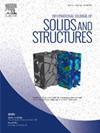Three-dimensional elastic–plastic lattice-spring model based on sapphire crystal structure and its application to impact characterisation studies
IF 3.4
3区 工程技术
Q1 MECHANICS
International Journal of Solids and Structures
Pub Date : 2024-10-10
DOI:10.1016/j.ijsolstr.2024.113097
引用次数: 0
Abstract
A thirteen-node octahedral three-dimensional lattice-spring model based on the sapphire crystal structure is established by applying the parameter mapping theory, and the finite element stiffness matrix is mapped into the linear spring stiffness coefficients of the lattice-spring model according to the parameter mapping method, so that the selection of the spring stiffness coefficients has a strict mathematical derivation. The elastic–plastic potential function that unifies the elastic–plastic characteristics of the material and the fracture energy is established. The lattice-spring model is tested by three algorithms, including longitudinal wave velocity, three-dimensional crack extension path under dynamic indentation, and impact compression deformation and lattice size sensitivity test, and the test results show that the established three-dimensional lattice-spring model has a high computational accuracy. The correctness of the calculation of the lattice-spring model is verified by comparing the calculation of the evolution process of spherical impact damage on the edge of sapphire under different crystal directions with the experiment.
基于蓝宝石晶体结构的三维弹塑性晶格弹簧模型及其在冲击特性研究中的应用
应用参数映射理论建立了基于蓝宝石晶体结构的十三节点八面体三维晶格弹簧模型,并根据参数映射方法将有限元刚度矩阵映射为晶格弹簧模型的线性弹簧刚度系数,从而使弹簧刚度系数的选择具有严格的数学推导。建立了统一材料弹塑性特征和断裂能的弹塑性势函数。通过纵波速度、动态压痕下三维裂纹扩展路径、冲击压缩变形与晶格尺寸敏感性试验等三种算法对晶格弹簧模型进行了测试,测试结果表明所建立的三维晶格弹簧模型具有较高的计算精度。通过比较不同晶向下蓝宝石边缘球形冲击损伤演变过程的计算结果与实验结果,验证了晶格弹簧模型计算的正确性。
本文章由计算机程序翻译,如有差异,请以英文原文为准。
求助全文
约1分钟内获得全文
求助全文
来源期刊
CiteScore
6.70
自引率
8.30%
发文量
405
审稿时长
70 days
期刊介绍:
The International Journal of Solids and Structures has as its objective the publication and dissemination of original research in Mechanics of Solids and Structures as a field of Applied Science and Engineering. It fosters thus the exchange of ideas among workers in different parts of the world and also among workers who emphasize different aspects of the foundations and applications of the field.
Standing as it does at the cross-roads of Materials Science, Life Sciences, Mathematics, Physics and Engineering Design, the Mechanics of Solids and Structures is experiencing considerable growth as a result of recent technological advances. The Journal, by providing an international medium of communication, is encouraging this growth and is encompassing all aspects of the field from the more classical problems of structural analysis to mechanics of solids continually interacting with other media and including fracture, flow, wave propagation, heat transfer, thermal effects in solids, optimum design methods, model analysis, structural topology and numerical techniques. Interest extends to both inorganic and organic solids and structures.

 求助内容:
求助内容: 应助结果提醒方式:
应助结果提醒方式:


